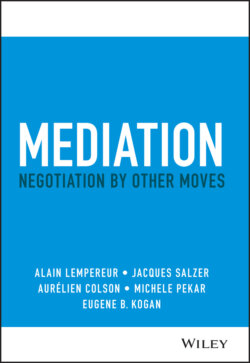Читать книгу Mediation - Alain Lempereur - Страница 12
Methods
ОглавлениеEveryone can improvise and play the role of a mediator, and some perform it well: between one's brothers and sisters, between one's parents and relatives in a dispute, and between classmates, or friends, or colleagues at work. Chapter 2 addresses the question of “informal mediators.”
The fact remains that, except for limited cases, effective mediation is rarely well founded on instinct only. There is no doubt that some people are more gifted at empathy than others. They might be seen as naturals in benevolent listening. However, they may not employ some fundamental tools of inquiry and probing, or restating that the mediator needs to master before running a session. Learning such tools on the job or by trial and error can be a slow process, and, worst of all, sometimes the consequence of avoidable failure. Mediation is therefore a matter of methods: principles and good practices exist, tools are available, techniques are checked, traps are identified – all forming a practical body that everyone can acquire and implement (Lempereur, Salzer, and Colson 2007). As mediation experience grows, such methods need to be tested, refined, and adjusted in an ongoing circle of learning.
Our book integrates both methods and experience. As academics and mediators in the field, including in high‐stress/‐stakes/‐impact environments, we combine knowledge and know‐how, as we have practiced and refined them over decades through a worldwide practice for international organizations, governments, NGOs, and corporations. As a result, the models, tools, and examples this book proposes develop several possible methods for mediation. We hope this book will be
helpful, whether you are a potential or a professional mediator, an involved party, a lawyer, an adviser, or a stakeholder;
practical (but not simplistic), as it offers operational principles; it raises real problems, and proposes concrete solutions;
subtle (but not abstruse), as it invites self‐awareness, persistent reflection, a capacity to review actions, and change course;
comprehensive, as it approaches mediation in general, as a process, in what is applicable to most types of mediation – diplomatic, family, criminal, consumer, labor, corporate, etc. – even if each domain has its specificities (Lempereur 1999b, 1999d);
specific, because it is a book that opens to every reader the possibility of choosing the moves and tools adapted to their needs, experience, and context – to build their own mediation path.
Writing this book is also a part of a broader objective that transcends the dimensions of a single book. It is about helping to reverse a paradoxical trend: Why is mediation still so little practiced around the world while its potential is so great? Although many organizations utilize third‐party facilitators, mediation remains a relatively little‐used mechanism compared with the plethora of cases in court. Maybe there is not yet, despite the advocacy efforts, enough accessible information on what, concretely, mediation offers: how is a decision made, what are its advantages and limits, how it unfolds, what are its phases, what is a mediator's role, what can the parties expect, etc.?
This is what this book proposes to share with the reader, so that more people, according to their circumstances, consider mediation a useful approach to overcome a conflict or even wish to become mediators themselves.
